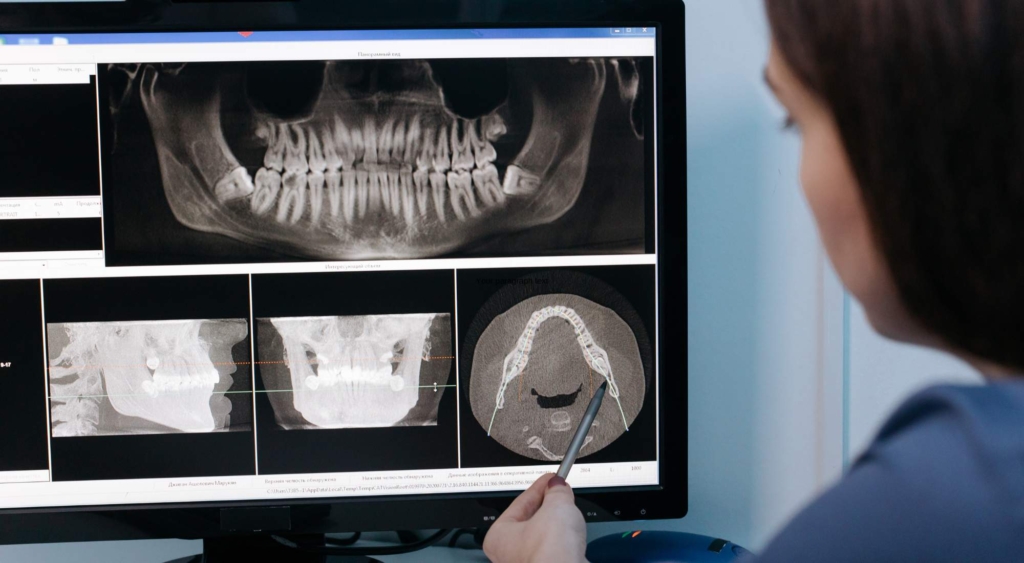Save Your Smile: Root Canal Tooth Decay Treatment
Though the cost of fixing your teeth may tempt you to put off professional dental care, tooth pain is not something you can ignore – especially when it begins to interfere with daily life. When you can no longer eat without serious discomfort or are getting headaches from the pain, it’s time to bite the bullet.
But is a root canal the only available option for saving your tooth?
Mint Dental Works explains what necessitates root canal treatment, the treatment itself, and why it is often preferable to having a tooth pulled.
Table of Contents
- Understanding Tooth Decay and Its Causes
- Signs and Symptoms That Indicate a Root Canal May Be Needed
- What Is a Root Canal? A Step-by-Step Overview
- Recovery and Aftercare: What to Expect
- How Long Will a Dead Tooth Last After a Root Canal?
- Benefits of a Root Canal Treatment Over Tooth Extraction
- Prevent Tooth Decay and Future Root Canals With Mint Dental Works
Understanding Tooth Decay and Its Causes
Tooth decay is the gradual destruction of the tooth by the acid byproducts of bacterial metabolism. Bacteria feed off sugars that remain in the mouth and secrete acid that erodes first the enamel, then the dentin, and finally the inner tooth material.
When the decay reaches the inner tooth material, called the pulp, the nerve and blood vessels supplying the tooth become inflamed. This causes pain and may lead to the complete destruction of the tooth and the spread of decay and infection to nearby teeth and the surrounding bone.
The removal of the infection and the decaying material is critical to prevent the formation of an abscess. If left untreated, an abscessed tooth can lead to other health problems, not to mention a considerable amount of pain.
Schedule an appointment with Mint Dental Works today to determine if you have tooth decay requiring root canal treatment.
Whatever your need, our professional practice can help. We utilize the latest technologies to make your dental care as quick, comfortable, and accurate as possible. Only a handful of dental practices have incorporated the high-tech equipment we use, such as:
- Diode laser, which cuts soft tissues more accurately with less trauma
- Digital radiography, which records images of your teeth more quickly than traditional X-rays and with less radiation exposure
- Cone beam CT, which generates clearer 3-dimensional images of soft tissues, dental structures, nerve paths, and the face
- CEREC technology, which allows us to provide single-visit crowns
Signs and Symptoms That Indicate a Root Canal May Be Needed
Early Signs of Decay
In the early stage of tooth decay, you may notice:
- Mild discomfort when biting or chewing
- Small holes on the tooth’s surface
- Visible discoloration:
- White spots due to the demineralization of the enamel.
- Dark spots where the enamel has begun to decay.
- Tooth sensitivity when you eat or drink something hot or cold, due to the beginning of dentin decay
At this stage, fluoride treatments may reverse mild decay by remineralizing your tooth’s enamel. Otherwise, you may need a filling. At Mint Dental Works, we do not give mercury-containing amalgam fillings. Instead, we use a resin composite that matches the color of your teeth.
Advanced Symptoms Requiring Urgent Care
Decay that has spread deeper into the tooth may cause:
- Severe, continuous pain that keeps you awake
- Swelling that may spread to the face, head, or neck
- The formation of an abscess, or a collection of pus in your gums or under teeth
- Prolonged sensitivity that isn’t only experienced while eating or drinking
When to See a Dentist
If you notice any changes in your teeth, especially pain, it is time to receive a professional evaluation. During your initial appointment, Mint Dental Works will perform a thorough assessment to determine what treatments your teeth require.
What Is a Root Canal? A Step-by-Step Overview
Diagnosing the Problem
If your teeth show signs of an infection, you may reasonably expect a root canal procedure in the near future. However, you might not have any symptoms and still need one.
Besides determining the precise extent of obvious maladies, this is one reason X-rays, gum measurements, scans, and other readings are important for diagnosing dental problems. Multiple methods of evaluation might reveal an infection deep in the root that doesn’t present with symptoms.

The Root Canal Procedure Explained
This is what you can expect on the day of your root canal procedure:
- The area around the tooth will be numbed with local anesthesia.
- A small drill is used to gain access to the inside of the tooth.
- Infected tissue and bacteria are removed.
- The area is scrubbed and scraped with specialized files and flushed with a cleaning solution.
- The tooth is sealed either immediately or after medication has successfully cleared the infection. The seal is a mixture of gutta-percha and an adhesive cement. Depending on the state of the tooth, it might also require a crown.
Modern Advances in Root Canal Treatment
Dentists who make use of recent technological advances like the ones listed below help to ensure success in the three main stages of root canal treatment (shaping, cleaning, sealing):
- Rotating files made of martensitic alloys allow even inexperienced dentists to safely widen root canals.
- Laser-assisted technologies allow more precise removal of infected material by less invasive (and thus less painful) means.
- Files can’t reach all areas of irregularly shaped canals. 3-dimensional cleaning requires the use of irrigants, whose cleaning power can now be activated using sonic, heat, and laser energy.
- 3-dimensional micro-CT imaging allows visualization of any gaps in the filler and sealant. This enables the dentist to guarantee complete obturation (sealing) of the area to prevent more bacteria from entering the root canal. (X-rays only permit a 2-dimensional view).
- Digital technologies allow for more precise administration of anesthesia to ensure minimal discomfort during the procedure.
Recovery and Aftercare: What to Expect
Immediate Post-Treatment Care
Right after a root canal procedure, you will be directed to:
- Take over-the-counter pain medication to relieve pain and swelling.
- Avoid eating or drinking for half an hour.
- Expect some discomfort for 2–4 days following treatment.
- Eat soft foods for a few days.
- Brush and floss regularly unless told otherwise.
- Avoid chewing or biting with the treated tooth until the permanent filling has been applied.
Recovery Timeline
You can expect to resume normal activities less than a week after a root canal procedure, but you may experience some soreness for up to two weeks.
The best way to maximize the lifespan of your teeth and prevent further complications after root canal treatment is to:
- Brush your teeth after each meal using a fluoride toothpaste.
- Eat a well-balanced diet.
- Floss every day.
- Visit the dentist regularly for exams and cleanings.
Signs of Complications & When to Call Your Dentist
Although root canal treatment is common and generally unproblematic, complications sometimes arise. If you have any of the following symptoms, contact your dentist:
- Persistent pain and swelling can be a sign of reinfection
- Swelling, hives, and difficulty breathing may signal an allergic reaction
- Tooth fracture or cracking may occur in the weakened tooth
How Long Will a Dead Tooth Last After a Root Canal?
Although a root canal-treated tooth is no longer supplied by the nerve and blood vessels, it is not strictly dead. It receives nutrients from nearby tissues and can last a lifetime with excellent oral hygiene. Generally, though, the tooth is expected to last about a decade.
Some factors that influence the tooth’s lifespan include:
- How bad the infection was and how thoroughly it was removed
- Its location
- Your age
- How carefully you comply with diet recommendations

Benefits of a Root Canal Treatment Over Tooth Extraction
A root canal is often preferable to a tooth extraction because the tooth helps preserve the arrangement of your other teeth. If the tooth is pulled, you will need an implant or bridge to prevent eventual misalignment. This might cost more in the long run.
The tooth, reinforced by a proper seal or crown, will also help preserve your jaw structure and physiognomy. Thus, a root canal treatment enables you to maintain a natural facial appearance, whereas a tooth extraction might create a sunken area.
Tooth extraction may also have other negative impacts, including:
- Causing sinus issues, depending on the tooth’s location
- Compromising the chewing function of your teeth by:
- Causing jawbone loss and loosening of the other teeth over time
- Changing your bite
Nevertheless, some dental situations may call for an extraction rather than a root canal. Contact Mint Dental Works for an evaluation to determine which is the better choice for you.
Prevent Tooth Decay and Future Root Canals With Mint Dental Works
If you’re looking for an excellent SE Portland dentist, Mint Dental Works is sure to meet your standards. Our high-quality care is intended to make your visit to the dentist as pleasant as possible. We offer the following services to help you improve and maintain your oral health:
- General dentistry
- Fillings
- Sealants
- Bridges
- Crowns
- Cancer screenings
- Cleanings
- Specialty dentistry
- Implants
- Periodontics (care of your gums)
- Endodontics (root canal treatment)
- Cosmetic dentistry
- Orthodontics
- Teeth whitening
- Veneers
As the first LEED-certified dental practice in the U.S., we’re committed to:
- Reducing waste and energy usage:
- We use an alcohol hand rub that eliminates the need for paper towels.
- We have a dry-evacuation system and low-flow fixtures that save water
- Our electricity is powered by renewable energy.
- Making our setting free of harmful chemicals:
- Our heating and cooling systems ensure the purest air possible
- Our building is constructed with eco-friendly materials
- We use only natural cleaning products.
- Providing care that will not harm our patients’ health:
- We use nitrile instead of latex gloves and a digital panoramic X-ray unit.
- We remove and safely dispose of mercury fillings.
Our wide variety of services, top-notch technologies, and sustainable practices make Mint Dental Works the perfect choice for all your dental needs, including root canals.
Call us today to schedule an appointment and learn what your teeth need to be their healthiest.
The content in this blog is not intended to be a substitute for professional medical advice, diagnosis, or treatment. Always seek the advice of your physician or other qualified health provider with any questions you may have regarding a medical condition.

